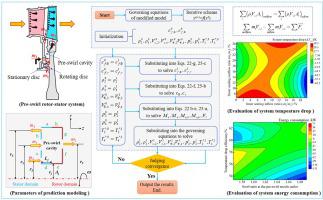Energy Conversion and Management ( IF 9.9 ) Pub Date : 2021-07-23 , DOI: 10.1016/j.enconman.2021.114440 Aqiang Lin 1, 2 , Gaowen Liu 1, 2 , Xinxin Wang 3 , Qing Feng 1, 2

|
Pre-swirl system has an indispensable role to supply enough cooling air with appropriate pressure, temperature, and mass flow rate to improve the life and the efficiency of turbine cooling blades and vanes. This study aimed to reveal the heat transfer mechanism and energy conversion characteristics of a multi-in and multi-out pre-swirl system. Subsequently, a novel modified prediction modeling was proposed to evaluate the system performance and energy conversion with complete consideration of multi-factors, especially for determining the influence of the seal flow, wall friction, work done by the rotating turbine disc, and rotor–stator moment. The results reveal that a high pre-swirl cooling performance and low-energy consumption can be obtained from the contribution of the airflow swirl ratio, whereas the swirl ratio was susceptible to the mixed seal flow. Thereafter, the seal outflow improved the system temperature-drop efficiency, whereas the seal inflow strongly influenced the heat transfer and energy consumption characteristics. The modified modeling resulted in a 56.89% increase in prediction accuracy relative to the Liu-model. Moreover, the nonlinear relationships between the seal flow and system performances can be comprehensively and accurately evaluated. In particular, a peak in a system temperature drop of 38.5 K can be realized with a low-energy consumption of −133 kW and a 64% enhancement in the air-supply flow rate based on a contribution of the seal flow on airflow swirl ratio. Thus, the implementation of the modified modeling can prove significant in theoretical guidance and engineering applications.
中文翻译:

燃气涡轮发动机预旋流转子-定子系统性能和能耗综合评价
预旋流系统对于提供足够的压力、温度和质量流量合适的冷却空气以提高涡轮冷却叶片和叶片的寿命和效率具有不可或缺的作用。本研究旨在揭示多进多出预旋流系统的传热机理和能量转换特性。随后,提出了一种新的修正预测模型,以全面考虑多因素来评估系统性能和能量转换,特别是确定密封流量、壁面摩擦、旋转涡轮盘所做的功和转子 - 定子的影响片刻。结果表明,气流涡流比的贡献可以获得较高的预涡流冷却性能和低能耗,而涡流比容易受到混合密封流的影响。此后,密封流出提高了系统的温降效率,而密封流入对传热和能耗特性产生了强烈影响。相对于 Liu 模型,修改后的建模导致预测精度提高了 56.89%。此外,可以全面准确地评估密封流量与系统性能之间的非线性关系。特别是在-133 kW的低能耗和基于密封流对气流涡流比的贡献的送风流量提高64%的情况下,可以实现38.5 K的系统温降峰值. 因此,修改后的建模的实施在理论指导和工程应用中具有重要意义。密封流出提高了系统的温降效率,而密封流入对传热和能耗特性产生了强烈影响。相对于 Liu 模型,修改后的建模导致预测精度提高了 56.89%。此外,可以全面准确地评估密封流量与系统性能之间的非线性关系。特别是在-133 kW的低能耗和基于密封流对气流涡流比的贡献的送风流量提高64%的情况下,可以实现38.5 K的系统温降峰值. 因此,修改后的建模的实施在理论指导和工程应用中具有重要意义。密封流出提高了系统的温降效率,而密封流入对传热和能耗特性产生了强烈影响。相对于 Liu 模型,修改后的建模导致预测精度提高了 56.89%。此外,可以全面准确地评估密封流量与系统性能之间的非线性关系。特别是在-133 kW的低能耗和基于密封流对气流涡流比的贡献的送风流量提高64%的情况下,可以实现38.5 K的系统温降峰值. 因此,修改后的建模的实施在理论指导和工程应用中具有重要意义。而密封流入强烈影响传热和能量消耗特性。相对于 Liu 模型,修改后的建模导致预测精度提高了 56.89%。此外,可以全面准确地评估密封流量与系统性能之间的非线性关系。特别是在-133 kW的低能耗和基于密封流对气流涡流比的贡献的送风流量提高64%的情况下,可以实现38.5 K的系统温降峰值. 因此,修改后的建模的实施在理论指导和工程应用中具有重要意义。而密封流入强烈影响传热和能量消耗特性。相对于 Liu 模型,修改后的建模导致预测精度提高了 56.89%。此外,可以全面准确地评估密封流量与系统性能之间的非线性关系。特别是在-133 kW的低能耗和基于密封流对气流涡流比的贡献的送风流量提高64%的情况下,可以实现38.5 K的系统温降峰值. 因此,修改后的建模的实施在理论指导和工程应用中具有重要意义。相对于 Liu 模型,预测准确度提高了 89%。此外,可以全面准确地评估密封流量与系统性能之间的非线性关系。特别是在-133 kW的低能耗和基于密封流对气流涡流比的贡献的送风流量提高64%的情况下,可以实现38.5 K的系统温降峰值. 因此,修改后的建模的实施在理论指导和工程应用中具有重要意义。相对于 Liu 模型,预测准确度提高了 89%。此外,可以全面准确地评估密封流量与系统性能之间的非线性关系。特别是在-133 kW的低能耗和基于密封流对气流涡流比的贡献的送风流量提高64%的情况下,可以实现38.5 K的系统温降峰值. 因此,修改后的建模的实施在理论指导和工程应用中具有重要意义。基于密封流对气流涡流比的贡献,5 K 可以实现 -133 kW 的低能耗和 64% 的空气供应流量增强。因此,修改后的建模的实施在理论指导和工程应用中具有重要意义。基于密封流对气流涡流比的贡献,5 K 可以实现 -133 kW 的低能耗和 64% 的空气供应流量增强。因此,修改后的建模的实施在理论指导和工程应用中具有重要意义。









































 京公网安备 11010802027423号
京公网安备 11010802027423号